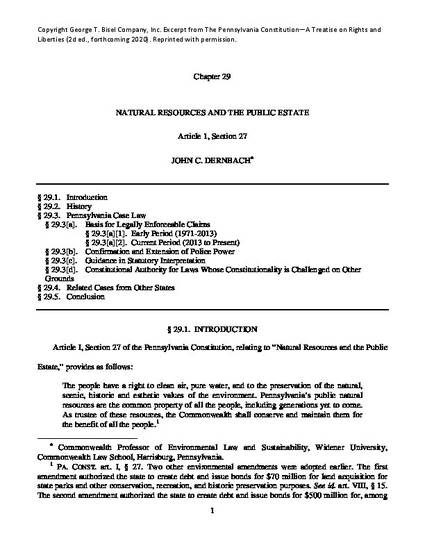
Contribution to Book
Natural Resources and the Public Estate; Article I, Section 27
The Pennsylvania Constitution—A Treatise on Rights and Liberties
(2020)
Abstract
This is a detailed explanation of the history and cases decided under Article I, Section 27 of the Pennsylvania Constitution, also known as the Environmental Rights Amendment. It is the final pre-publication version of the chapter on the Amendment in The Pennsylvania Constitution: A Treatise on Rights and Liberties (Ken Gormley et al., eds., forthcoming 2020).
The Amendment has two parts. The first part creates a right in “the people” to clean air, pure water, and the preservation of certain values. The second part articulates the right of “the people” to the state’s public natural resources, and establishes a right in “the people” to have those resources conserved and maintained for the benefit of present and future generations. The amendment is located in Article I of the Pennsylvania constitution (the subject of the treatise), which is Pennsylvania’s Declaration of Rights, analogous to the U.S. Bill of Rights. Pennsylvania is one of few states in the country to recognize the environmental rights of its citizens, and is perhaps the most prominent.
This treatise chapter first explains the history of the Amendment. It then describes four ways that courts have applied it. The first and most obvious is as a basis for legally enforceable claims. For more than four decades, Pennsylvania courts avoided applying the text of the Amendment, using instead a judicially invented test as a substitute for the text and greatly weakening the Amendment’s effect. Beginning with a plurality opinion in 2013 in Robinson Township v. Commonwealth, and then a majority opinion in 2017 in Pennsylvania Environmental Defense Foundation v. Commonwealth, the Pennsylvania Supreme Court used the text of the Amendment to hold legislation unconstitutional, and discarded the judicially invented test. This chapter also explains that Pennsylvania courts have applied the Amendment in three other ways—as confirmation and extension of the police power, as guidance in statutory interpretation, and as constitutional authority for laws whose constitutionality has been challenged on other grounds.
Keywords
- Pennsylvania Supreme Court,
- Robinson Township,
- Pennsylvania Environmental Defense Foundation,
- constitutional environmental law,
- environment,
- environmental,
- environmental law,
- public trust,
- Article I Section 27,
- Pennsylvania constitution,
- environmental rights,
- Pennsylvania Commonwealth Court
Disciplines
- Law and
- Environmental Law
Publication Date
2020
Publisher
George T. Bisel Company, Inc
Citation Information
John C. Dernbach. "Natural Resources and the Public Estate; Article I, Section 27" 2ndThe Pennsylvania Constitution—A Treatise on Rights and Liberties (2020) Available at: http://works.bepress.com/john_dernbach/163/
